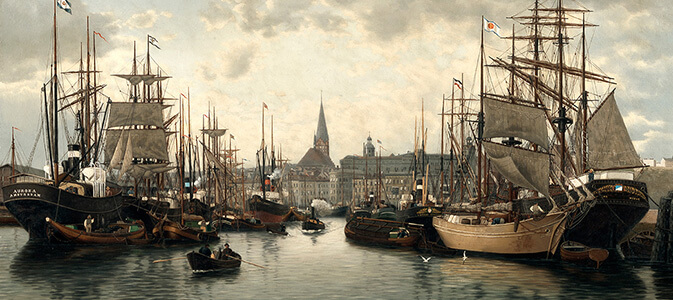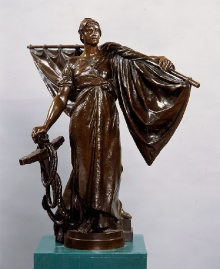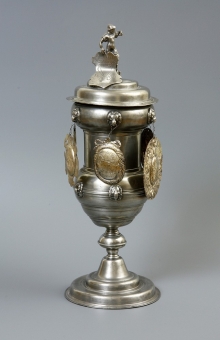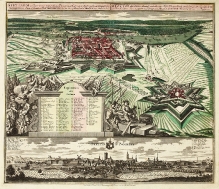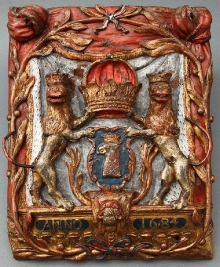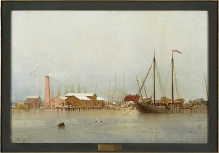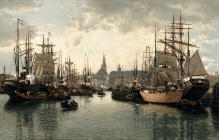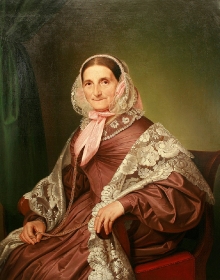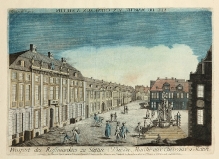The exhibition presents modern history of the city, illustrates important events, economical development, local crafts and industry and people related to Szczecin under Swedish, Prussian and German rules.
Various craft wares – made of tin, ceramics, silver; church and secular artworks, paintings, old plans, pictures and documents illustrate particular stages of the city life, show important architectural and urban development changes.
The exhibition is opened by a five-meter-long painting on a board with the panorama of the city seen from the river – this is how Szczecin looked like in early 17th century. The buildings are dominated by churches, among which impressive, today non-existent St. Mary's church distinguishes together with stunning mass of the castle. In the centre, beside a very scarce image of gothic town hall, there is St. Nicholas' church, and beside the city walls in the North there are old Cisterician convent and two duke's residences: small summer pavilion (Lusthaus) and former Carthusian monastery re-arranged into Oder Castle (Oderburg) in Grabowo.
Not much time later, this picture underwent serious transitions resulting from complicated political situation in Europe. Thirty Years' War and conflict between Sweden and Brandenburg of succession in Pomerania after the perishing of the House of Griffins involved Szczecin into a war that lasted for almost the whole 18th century. The city, occupied by Swedes, as soon, as in 1630 was surrounded by modern system of fortifications, which had to defend the oversea bridgehead of Swedish dominions. They did not, however, protect it from serious damage from bombings during several sieges of the army of the anti-Swedish coalition.
After old citizens of Szczecin, including masters known by names, there remained numerous craft wares used in local offices, apartments, workshops, churches, houses of wealthy patritionas and humble citizens. The exhibition shows, among others, various tin vessels – pitchers, mugs, plates and Willkomms of many local craft guilds and matrixes of their seals.
Despite official introduction of Lutheran religion in Pomerania in 1534, in churches still remained numerous relics of old church art, gradually replaced by paintings characteristic for the new faith. They include a group portrait of the representatives of the board of St. Gertrude community in Łasztownia and a relief illustrating the Agony in the Garden – private foundations for St. John's church from 1657.
New chapter in the history of Szczecin was sealed by the peace of Stockholm, according to which in 1720 part of Pomerania with Szczecin was joined to Prussia. From a peripherial garrison centre, Szczecin returned to the role of the capital of the Pomeranian Province. In years 1724–1740, under Gerhard Cornelius Walrave's direction, the city fortifications were enlarged by three great forts, which, together with gates – decorated with rich Baroque ornamentation – and impressive parade places in former moats, had to show the rank of the city and its new ruler – the Prussian king.
After years of stagnacy and destruction, also the very city gradually began to change its character. The Horse Market (present White Eagle Place) became a representative area, where growing in wealth burghers and officials erected stunning buildings. Among the most famous there were birthplaces of Sophie Auguste von Anhalt-Zerbst, later emperess Catherine II and Dorothea von Würtenberg, wife of Tsar Paul I, as well, as seats of local elite – merchants, ship and manufactory owners.
After a crisis caused by French occupation (1806–1813) Szczecin entered a phase of transparent changes, a driving force of which was the port, developing trade and companies, which were the beginning of industry. However, only as late, as in the last quarter of the 19th century, after the liquidation of the fortifications, there occurred spectacular spacial and economical development of the city, governed by successful mayor Hermann Haken. Shipyards became the leaders of industry. The largest of them – „Vulcan” – became famous for producing ships for trade and military fleets, and, above all, splendid and world's fastest passenger transatlantic liners. Models of all ships of „Vulcan” were stored in the impressive City Museum. Only few objects remained from the great collection. One of them – cross-sectional model of „P”-type steamer – can be seen in the exhibition.
Considerably developed port with duty-free zone received ships form all over the world. Constantly changing area of the riverside main embankment became important for economy, but also for the city population, tourists and artists, creating numerous vedutes here. Among pearls of the city there was a statue by Ludwig Manzel, which symbolized Szczecin's relations to sailing and trade and maritime traditions of the port city.
- L. Manzel, Model postaci kobiecej do fontanny Sediny, 1896-98, brąz (fot. G. Solecki).
- Author: No Data
- Cynowy wilkom cechu krawców ze srebrnymi zawieszkami, 1 ćw. XVIII w. (fot. G. Solecki).
- Author: No Data
- Gabriel Bodenehr, Plan Szczecina z umocnieniami, Augsburg, 1720-1740, miedzioryt (fot. G. Solecki).
- Author: No Data
- Heinrich Redtel (?), Portret zbiorowy zarządu gminy kościoła św. Gertrudy w Szczecinie, 1666 r., olej/deska (fot. G. Solecki).
- Author: No Data
- G. M. Seutter wg J. F. Freunda / G. P. Buscha i F.B. Wernera, Widok Szczecina od zachodu i panorama od południowego-wschodu, Augsburg, 1736 r., miedzioryt ręcznie kolorowany (fot. G. Solecki).
- Author: No Data
- Kartusz herbowy Szczecina z okresu szwedzkiego, drewno polichromowane (fot. G. Solecki).
- Author: No Data
- Artysta nieznany wg Joh. Gottfrieda Schadowa, Miniatura szczecińskiego pomnika Fryderyka Wielkiego, pocz. XX w., alabaster (fot. G. Solecki).
- Author: No Data
- Monogramista J.R., Port szczeciński z panoramą miasta, 1899 r., olej na płótnie, własność BRE Bank SA (fot. G. Solecki).
- Author: No Data
- August Ludwig Most, Portret starszej damy z szalem, 1842, olej/płótno (fot. G. Solecki).
- Author: No Data
